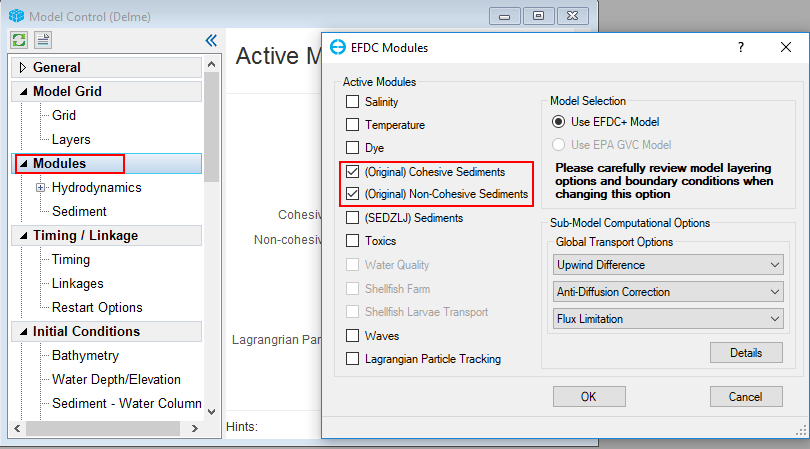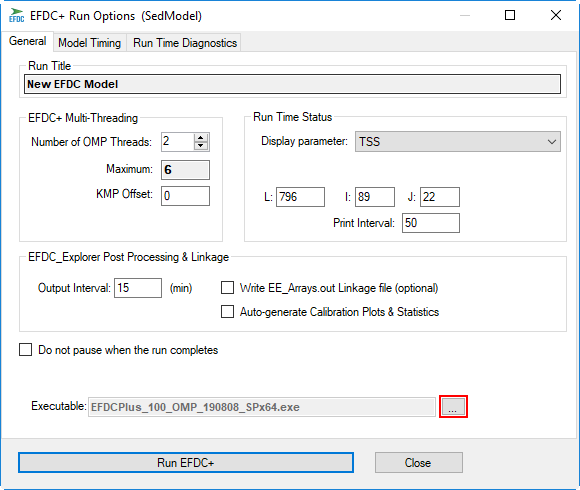...
...
...
...
...
...
1 Introduction
This tutorial document will guide you on how to setup set up a coastal sediment model based on the Tra _ Khuc Estuary example that is available from the EEMS website. It is assumed in the following guidance that the hydrodynamic model of Tra _ Khuc has been set so so that the sediment transport can be added to this model. The hydrodynamic model need can be downloaded from this link Build a 3D Coastal Model .
2 Generate a Sediment Transport Model
Open the Tra Khuc Hydrodynamic Model (3D Coastal Sediment Model - Tra_Khuc EstuaryFigure 1).
| Anchor | ||||
|---|---|---|---|---|
|
...
Figure 1. EE main form of Tra _ Khuc Hydrodynamic Model.
2.1 Activate Sediment Modules
- In the Model Control form, RMC on Modules to open the EFDC Modules window.
- In EFDC Modules, check the boxes (Original) Cohesive Sediments and (Original) Non-Cohesive Sediments to activate sediment then click OK. The Sediments item will be added under Modules.
| Anchor | ||||
|---|---|---|---|---|
|
Figure 2. Activate the sediment module.
2.2 Set Sediment Transport Parameters and Options
- Right Mouse Click on Sediments tab under Modules then click Settings to open Sediments and Sediment Bed Properties window (3D Coastal Sediment Model - Tra_Khuc EstuaryFigure 3).
- In the General tab the user inputs the number of Sediment Bed Layers, Cohesives, and Non-cohesives (3D Coastal Sediment Model - Tra_Khuc EstuaryFigure 4)
| Anchor | ||||
|---|---|---|---|---|
|
...
Figure 4. Sediment Transport – General tab.
Cohesives Tab
The user should input the values as shown in 3D Coastal Sediment Model - Tra_Khuc Estuary Figure 5 for the cohesive class.
Anchor #Figure 5 #Figure 5
...
Figure 5. Sediment Transport – Cohesives tab.
Non-Cohesives Suspended Tab
The user ahould should input values for IC WC Conc, IC Bed Mass, Specific Gravity, and Median Diameter as shown in 3D Coastal Sediment Model - Tra_Khuc Estuary Figure 6. In the Equilibrium Conc, check on Van Rijin then click Set Parameters to initialize the sediment properties using the Van Rijn equations.
...
Figure 6. Sediment Transport – Non-Cohesives Suspended tab.
Non-Cohesives Bedload
The Non-Cohesives Bedload tab is shown in 3D Coastal Sediment Model - Tra_Khuc Estuary Figure 7. Pressing the Initialize Constants button will bring up a dialog box asking the user to select the bedload approach to use (3D Coastal Sediment Model - Tra_Khuc EstuaryFigure 8). EFDC_+ Explorer sets the bed load bedload transport constants to standard literature values for the computational approach selected.
Enter "1" then click OK button. Click Set All button to set all non-cohesive bedload to the current class (3D Coastal Sediment Model - Tra_Khuc EstuaryFigure 7).
Anchor #Figure 7 #Figure 7
...
Figure 8 Bedload Constants Initialization form.
Morphology and Consolidation Tab
The Morphology & Consolidation tab of the sediment properties option is shown in 3D Coastal Sediment Model - Tra_Khuc Estuary Figure 9. In this tab, the user may specify various bed consolidation and bed morphology settings.
...
Figure 9 Sediment Transport – Morphology and Consolidation tab.
Bed Processes
The Bed Processes is shown in 3D Coastal Sediment Model - Tra_Khuc Estuary Figure 10.
Anchor #Figure 10 #Figure 10
...
Figure 10. Sediment Transport – Bed Processes tab.
Initial Conditions Tab
There are several ways to build sediment beds in EFDC_+ Explorer. The simplest option is to create a uniform bed as shown in 3D Coastal Sediment Model - Tra_Khuc Estuary. Other Figure 11. Another option, using a sediment cores core with grain-size which is described in Sediment Bed Core Initialization.
The sediment parameters form with the Initial Conditions tab selected is shown in 3D Coastal Sediment Model - Tra_Khuc Estuary Figure 11.
- Select Spatially Varying Bed Conditions; Specify Mass Fraction
- Click Create Assign Bed IC button, Initialization of Sediment Beds window will appear (3D Coastal Sediment Model - Tra_Khuc EstuaryFigure 12). Click on Create Uniform Bed.
- Inorganic Sediment Bed Constructor window appears, enter values for uniform cohesives and non-cohesives as shown in 3D Coastal Sediment Model - Tra_Khuc Estuary Figure 13
- Then click Create Sediment Bed button
- Click on OK
...
Figure 13. Uniform Sediment Bed Generation form.
2.3 Set Up Boundary Conditions for Sediment
1. From Model Control form, under External Forcing Data, RMC on Cohesives Sediment and select Add New Data Series (See 3D Coastal Sediment Model - Tra_Khuc Estuary Figure 14) then the Boundary Data Series form appears.
...
3. Input the name of the series as "River" in Series Name then press Enter key from the keyboard.
4. Enter time-series data of cohesive sediment from 3D Coastal Sediment Model - Tra_Khuc Estuary Figure 14 then click OK button to finish.
...
5. Add data time series for Non-Cohesives Sediment as shown in 3D Coastal Sediment Model - Tra_Khuc Estuary and 3D Coastal Sediment Model - Tra_Khuc Estuary Figure 16 and Figure 17 (remember to put in data for 3 non-cohesive classes)
...
Figure 17. Non-cohesive sediment data series.
2.4 Assigning the sediment concentration BC
1. Return to the Model Control form, RMC on the River under Flow of the Boundary Conditions tab then select Edit Boundary Group (3D Coastal Sediment Model - Tra_Khuc EstuaryFigure 18)
Anchor #Figure 18 #Figure 18
...
2. The Flow Boundary Conditions form appears as shown in 3D Coastal Sediment Model - Tra_Khuc Estuary Figure 19, in Boundary Group Conditions, from the drop-down list, select data series with named as "River" for Cohesive Sediment and Non-cohesive Sediments , then OK button.
...
Figure 19. Boundary Condition Definition/Groups form.
3 Save and Run Sediment Model
- Click the Save Project button on the top of EE form to save the model again as shown in 3D Coastal Sediment Model - Tra_Khuc Estuary Figure 20.
- Click the Run EFDC button, the EFDC+ Run Options frame appears as shown in 3D Coastal Sediment Model - Tra_Khuc Estuary Figure 21. On this form, the user can set the number of threads, output interval then browse to the EFDC+ executable file. Then click Run EFDC+ button to run the model.
- The EFDC+ run window is shown in 3D Coastal Sediment Model - Tra_Khuc Estuary Figure 22.
Anchor #Figure 20 #Figure 20
| #Figure 20 | |
| #Figure 20 |
Figure 20. Save and run model.
Anchor #Figure 21 #Figure 21
| #Figure 21 | |
| #Figure 21 |
Figure 21. EFDC+ Run Options.
...


